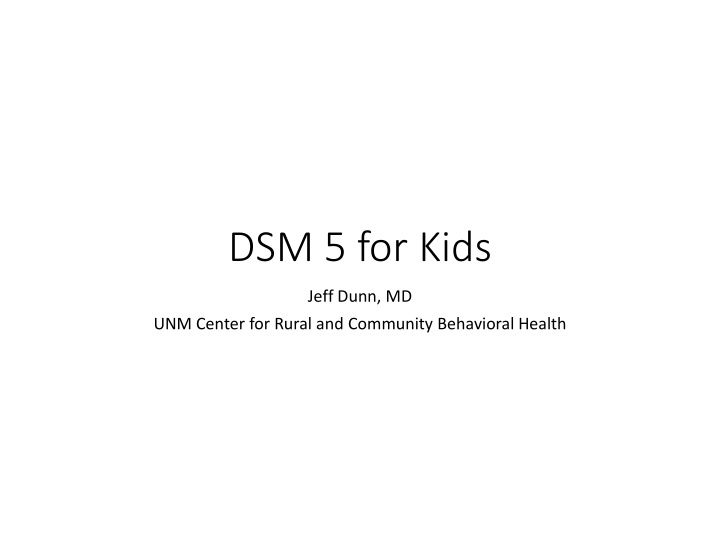



DSM 5 for Kids Jeff Dunn, MD UNM Center for Rural and Community Behavioral Health
Criticisms/Controversies • Lack of transparency? (non-disclosure agreements) • Low reliability (kappa) in field trials • Ties to pharmaceutical industry? (70 % of task force members) • “Medicalization” of normal individual variation? (e.g., Disruptive Mood Dysregulation Disorder)
Elimination of Multi-axial System • “To remove artificial distinctions between medical and mental disorders” • Axis IV: a number of psychosocial and environmental conditions can be coded as V Codes • Axis V (GAF): can be replaced by WHO Disability Assessment Schedule and other assessment measures: • http://www.psychiatry.org/practice/dsm/dsm5/online-assessment- measures
NOS • Replaced by: • Other Specified Mental Disorder : to be used when the clinician wants to specify why the presentation does not meet criteria for a specific disorder • Unspecified Mental Disorder : to be used when the clinician does not want to specify or there is insufficient information to make a definite diagnosis
NEURODEVELOPMENTAL DISORDERS
Intellectual Disability • Intellectual Disability (Intellectual Developmental Disorder) replaces the term Mental Retardation • Severity is determined by adaptive functioning rather than cognitive capacity (IQ)
Autism Spectrum Disorder • Encompasses autism, Asperger’s disorder, childhood disintegrative disorder and pervasive developmental disorder NOS • Characterized by 1) deficits in social communication and social interaction and 2) restricted repetitive behaviors • Severity coded by levels (1: “requiring support”; 2: “requiring substantial support”; 3: “requiring very substantial support”)
Social Communication Disorder* • Persistent difficulty with verbal and nonverbal communication that cannot be explained by low cognitive ability • The child’s acquisition and use of spoken and written language is problematic, and responses in conversation are often difficult
ADHD • For children, onset has been changed from before 7 years of age to before 12 years of age • Symptoms continue to be drawn from inattention cluster and hyperactivity/impulsivity cluster • Co-morbid diagnosis of ASD now allowed
PSYCHOTIC DISORDERS
Schizophrenia • Schizophrenia subtypes have been dropped • Individual must have at least one of the following: delusions, hallucinations, disorganized speech • Bizarre delusions or “first rank” hallucinations no longer given special weight
BIPOLAR AND RELATED DISORDERS
Bipolar Disorder • Emphasizes changes in activity and energy during a manic or hypomanic episode, as well as mood • “Mixed Episode” has been removed; replaced with specifier “with mixed features” (can also be applied to MDD) • A specifier for “anxious distress” has also been added
DEPRESSIVE DISORDERS
Major Depressive Disorder • Criteria largely unchanged, with important exception of elimination of the “bereavement exclusion” • Formerly, MDD could not be diagnosed within 2 months following the death of a loved one • Guidelines for distinguishing grief from MDD given in a footnote (eg, grief: occurs in “pangs”, positive emotion still present, self esteem preserved)
Persistent Depressive Disorder • Includes dysthymic disorder (dropped from DSM 5) and chronic major depressive disorder • “depressed mood for most of the day, on more days than not…for at least 2 years”
Premenstrual Dysphoric Disorder • Moved from Appendix to “main body” • “in the majority of menstrual cycles, at least 5 symptoms must be present in the final week before the onset of menses”
Disruptive Mood Dysregulation Disorder* • “To address concerns about potential overdiagnosis and overtreatment of bipolar disorder in children.” • For children 6-18 years old who exhibit persistent irritability and frequent episodes of extreme behavioral dyscontrol (temper outbursts) • Symptoms present for at least 12 months in at least 2 settings
TRAUMA AND STRESSOR- RELATED DISORDERS*
Disinhibited Social Engagement Disorder* • Once a subtype of reactive attachment disorder (indiscriminately social/disinhibited vs emotionally withdrawn/inhibited), now a separate diagnosis
Posttraumatic Stress Disorder • Criteria A explicit regarding whether individual has experienced trauma directly, witnessed trauma, or experienced indirectly • Subjective reaction (“fear, helplessness, horror”) has been eliminated • Expansion to 4 symptom clusters: intrusion, alterations in arousal and reactivity, avoidance, persistent alterations in cognition and mood
PTSD for Children 6 yrs and Younger • Lower threshold for making the diagnosis: • 2 arousal symptoms • 1 intrusion symptom • 1 symptom of either avoidance or negative alteration of mood/cognition
SOMATIC SYMPTOM AND RELATED DISORDERS
• Somatic symptom disorder (individuals with somatic symptoms— who may or may not have a diagnosed medical condition—plus maladaptive thoughts, feelings and behaviors) replaces somatization disorder and undifferentiated somatoform disorder • Hypochondriasis has been dropped—cases now to be diagnosed with SSD or illness anxiety disorder (the latter if no somatic symptoms present)
FEEDING AND EATING DISORDERS
• For anorexia, requirement for amenorrhea has been dropped • For bulimia, threshold has been lowered from 2 episodes per week to 1 • BINGE EATING DISORDER*- recurring episodes of bingeing (minimum: once weekly for 3 months) accompanied by feelings of guilt or embarrassment
Gender Dysphoria
Gender Dysphoria in Children • Replaces term Gender Identity Disorder • Gender non-conformity not in itself a mental disorder • Must be associated with significant distress • Marked difference between a child’s experienced gender and the gender others would assign to him or her • The desire to be of the other gender must be verbalized
• Oppositional Defiant Disorder-three subtypes: angry/irritable; vindictiveness; argumentative/defiant; conduct disorder exclusion removed • Intermittent Explosive Disorder-physical aggression was required in DSM IV, whereas verbal aggression and non-destructive/non- injurious physical aggression now suffice
SUBSTANCE RELATED AND ADDICTIVE DISORDERS
Criteria/Terminology Changes • Abuse and dependence no longer separated; subsumed under category Substance Use Disorder • Criteria nearly identical, with two exceptions: “recurrent legal problems” dropped; craving or strong desire to use substance added • Threshold is two criteria; severity is based on the number of criteria: 2-3 mild; 4-5 moderate; 6 or more severe • Substance, rather than category, should be specified
Recommend
More recommend